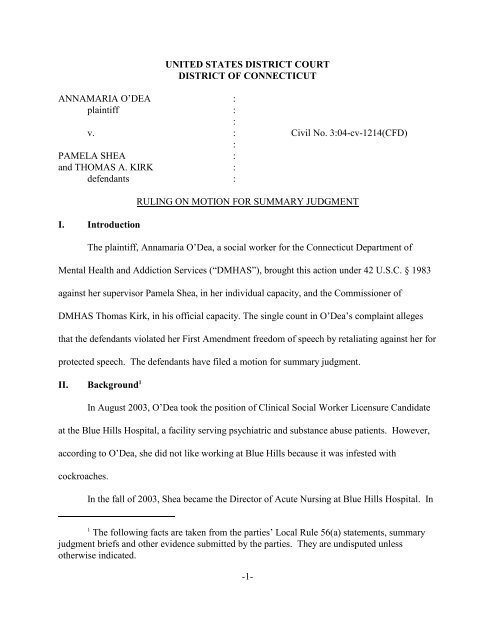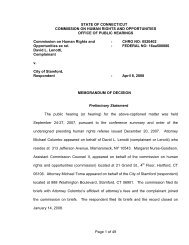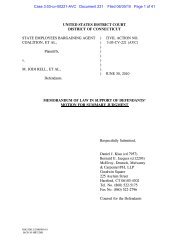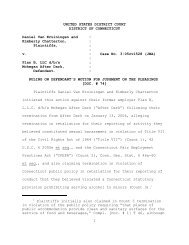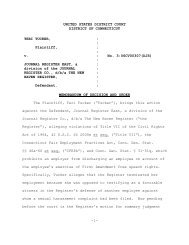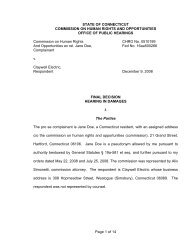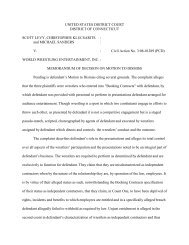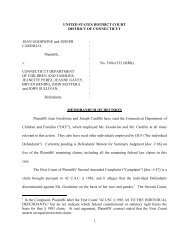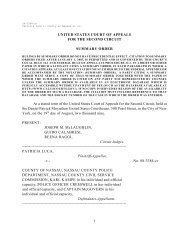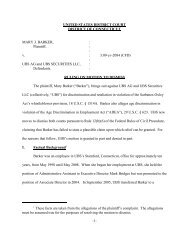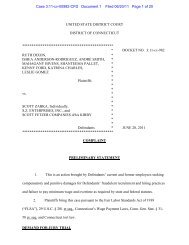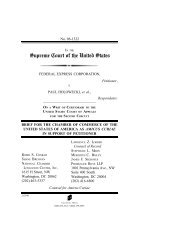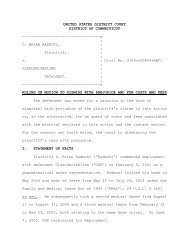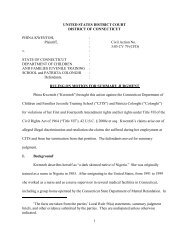O'Dea v. Shea, et al - Connecticut Employment Law Blog
O'Dea v. Shea, et al - Connecticut Employment Law Blog
O'Dea v. Shea, et al - Connecticut Employment Law Blog
- No tags were found...
You also want an ePaper? Increase the reach of your titles
YUMPU automatically turns print PDFs into web optimized ePapers that Google loves.
UNITED STATES DISTRICT COURTDISTRICT OF CONNECTICUTANNAMARIA O’DEA :plaintiff ::v. : Civil No. 3:04-cv-1214(CFD):PAMELA SHEA :and THOMAS A. KIRK :defendants :I. IntroductionRULING ON MOTION FOR SUMMARY JUDGMENTThe plaintiff, Annamaria O’Dea, a soci<strong>al</strong> worker for the <strong>Connecticut</strong> Department ofMent<strong>al</strong> He<strong>al</strong>th and Addiction Services (“DMHAS”), brought this action under 42 U.S.C. § 1983against her supervisor Pamela <strong>Shea</strong>, in her individu<strong>al</strong> capacity, and the Commissioner ofDMHAS Thomas Kirk, in his offici<strong>al</strong> capacity. The single count in O’Dea’s complaint <strong>al</strong>legesthat the defendants violated her First Amendment freedom of speech by r<strong>et</strong><strong>al</strong>iating against her forprotected speech. The defendants have filed a motion for summary judgment.II. Background 1In August 2003, O’Dea took the position of Clinic<strong>al</strong> Soci<strong>al</strong> Worker Licensure Candidateat the Blue Hills Hospit<strong>al</strong>, a facility serving psychiatric and substance abuse patients. However,according to O’Dea, she did not like working at Blue Hills because it was infested withcockroaches.In the f<strong>al</strong>l of 2003, <strong>Shea</strong> became the Director of Acute Nursing at Blue Hills Hospit<strong>al</strong>. In1The following facts are taken from the parties’ Loc<strong>al</strong> Rule 56(a) statements, summaryjudgment briefs and other evidence submitted by the parties. They are undisputed unlessotherwise indicated.-1-
the Spring of 2004, <strong>Shea</strong> purchased refurbished used furniture for the D<strong>et</strong>oxification Unit at thehospit<strong>al</strong>. When O’Dea found out about the purchase, she spoke with <strong>Shea</strong>, in <strong>Shea</strong>’s office,about her concern that use of refurbished furniture in a medic<strong>al</strong> unit “raises a lot of he<strong>al</strong>th careissue [sic].” According to O’Dea, she was concerned that bringing used furniture into the facilitywould lead to more insect infestations.In May 2004, <strong>Shea</strong> gave O’Dea a “satisfactory” written ev<strong>al</strong>uation that contained2unfavorable materi<strong>al</strong>. <strong>Shea</strong> claims that she received this ev<strong>al</strong>uation as a result of her complaintconcerning <strong>Shea</strong>’s purchase of the furniture.III.Summary Judgment StandardIn a summary judgment motion, the burden is on the moving party to establish that thereare no genuine issues of materi<strong>al</strong> fact in dispute and that it is entitled to judgment as a matter oflaw. See Fed. R. Civ. P. 56; Anderson v. Liberty Lobby, Inc., 477 U.S. 242, 256 (1986). A courtmust grant summary judgment “if the pleadings, depositions, answers to interrogatories, andadmissions on file, tog<strong>et</strong>her with the affidavits, if any, show that there is no genuine issue as toany materi<strong>al</strong> fact.” Celotex Corp. v. Catr<strong>et</strong>t, 477 U.S. 317, 322 (1986) (quoting Fed. R. Civ. P.5(c)); accord Miner v. Glen F<strong>al</strong>ls, 999 F.2d 655, 661 (2d Cir. 1993). A dispute regarding amateri<strong>al</strong> fact is genuine “if the evidence is such that a reasonable jury could r<strong>et</strong>urn a verdict forthe nonmoving party.” Anderson, 477 U.S. at 248.Where, as in this case, the nonmoving party has the burden of proof at tri<strong>al</strong>, the moving2According to the ev<strong>al</strong>uation, <strong>Shea</strong> compl<strong>et</strong>ed the ev<strong>al</strong>uation on April 1, 2004 and gave itto O’Dea on May 25, 2004. The Complaint <strong>al</strong>leges that <strong>Shea</strong> backdated the ev<strong>al</strong>uation. InFebruary 2004, O’Dea received an ev<strong>al</strong>uation indicating that she performed at a “satisfactory”level in approximately 80 percent of areas ev<strong>al</strong>uated, and at the “above average” or “outstanding”level in the remaining areas.-2-
party need only demonstrate that there is a lack of evidence to support the nonmovant's claim.Celotex, 477 U.S. at 323-25; Tops Mkts., Inc. v. Qu<strong>al</strong>ity Mkts., Inc., 142 F.3d 90, 95 (2d Cir.1998). Once the movant has established a prima facie case demonstrating the lack of a genuineissue of materi<strong>al</strong> fact, the nonmoving party must provide enough evidence to support a juryverdict in its favor. Anderson, 477 U.S. at 248; Bryant v. Maffucci, 923 F.2d 979, 982 (2d Cir.1991). A plaintiff may not rely on conclusory statements or mere contentions that the evidencein support of summary judgment is not credible. Ying Jing Gan v. City of New York, 996 F.2d522, 532 (2d Cir. 1993). Similarly, a plaintiff, as the nonmovant, may not rest “upon the mere<strong>al</strong>legations or deni<strong>al</strong>s” in its complaint to demonstrate the existence of a genuine issue ofmateri<strong>al</strong> fact. Fed. R. Civ. P. 56(e). Therefore, after discovery, if the nonmoving party “hasfailed to make a sufficient showing on an essenti<strong>al</strong> element of [its] case with respect to which [it]has the burden of proof,” then summary judgment is appropriate. Celotex, 477 U.S. at 323.When addressing a motion for summary judgment, the Court resolves “<strong>al</strong>l ambiguities anddraw[s] <strong>al</strong>l inferences in favor of the nonmoving party in order to d<strong>et</strong>ermine how a reasonablejury would decide.” Aldrich v. Randolph Cent. Sch. Dist., 963 F.2d 520, 523 (2d Cir. 1992).Thus, “[o]nly when reasonable minds could not differ as to the import of the evidence issummary judgment proper.” Maffucci, 923 F.2d at 982.IV.The Defendants’ Motion for Summary JudgmentThe defendants argue that they are entitled to summary judgment because (1) O’Dea’sspeech about the furniture was not constitution<strong>al</strong>ly protected; (2) O’Dea was not subjected to anadverse job action; and (3) <strong>Shea</strong> is protected by the doctrines of qu<strong>al</strong>ified and sovereignimmunity.-3-
“[P]ublic employees do not surrender <strong>al</strong>l their First Amendment rights by reason of theiremployment. Rather, the First Amendment protects a public employee's right, in certaincircumstances, to speak as a citizen addressing matters of public concern.” Garc<strong>et</strong>ti v. Ceb<strong>al</strong>los,--- U.S. ----, ----, 126 S.Ct. 1951, 1957, 164 L.Ed.2d 689 (2006). However, “[r]estricting speechthat owes its existence to a public employee’s profession<strong>al</strong> responsibilities does not infringe anyliberties the employee might have enjoyed as a private citizen.” Id. at 1960.In Garc<strong>et</strong>ti a supervising district attorney was disciplined for writing a memorandumrecommending dismiss<strong>al</strong> of a case on the basis of purported government misconduct. Id. TheUnited States Supreme Court found that the district attorney was not protected by the FirstAmendment in that instance because he “spoke as a prosecutor fulfilling a responsibility toadvise his superiors how best to proceed with a pending case” and not as a citizen. Id. at 1960.The Supreme Court found that “[e]mployers have heightened interests in controlling speechmade by an employee in his or her profession<strong>al</strong> capacity. . . [and that s]upervisors must ensur<strong>et</strong>hat their employees’ offici<strong>al</strong> communications are accurate, demonstrate sound judgment, andpromote the employer’s mission.” Id. The Court suggested that in d<strong>et</strong>ermining wh<strong>et</strong>her speechis uttered pursuant to employment “[t]he proper inquiry is a practic<strong>al</strong> one” and that wh<strong>et</strong>herviews are expressed in the office, concern the subject matter of employment, and wh<strong>et</strong>her thesubject speech is required by a form<strong>al</strong> job description are nondispositive. Id. at 1959, 1962.“In Garc<strong>et</strong>ti, Ceb<strong>al</strong>los [the prosecutor] was acting pursuant to his offici<strong>al</strong> duties becausehe was performing activities required to fulfill his duties.” Williams v. D<strong>al</strong>las Indep. SchoolDist., 480 F.3d 689, 693 (5th Cir. Feb. 13, 2007). Cf. Pagani v. Meriden Bd. of Educ., No.3:05-CV-01115 (JCH), 2006 WL 3791405, at *4 (D. Conn. Dec. 19, 2006) (holding that teacher-4-
who filed report with the <strong>Connecticut</strong> Department of Children and Families “was not speaking asa citizen but as a teacher performing a duty imposed on him [by law] as a result of his position”);Battle v. Bd. of Regents, 468 F.3d 755 (11th Cir. 2006) (university employee’s report <strong>al</strong>legingimpropri<strong>et</strong>ies in handling of financi<strong>al</strong> aid funds made pursuant to employment responsibilitiesand DOE guidelines requiring reporting fraud). However, an employee may still be performinghis job when he speaks, even if that expression is not demanded of him. Linskey v.Bristol, 3:05-CV-872 (CFD), 2007 WL 963179 (D. Conn., March 30, 2007) (holding that actingemergency response team commander was acting pursuant to job duties when he complainedabout failure to activate team). See <strong>al</strong>so Williams v. D<strong>al</strong>las Indep. School Dist., 480 F.3d at 693(holding that public school athl<strong>et</strong>ic director was performing job when he wrote to office managerand princip<strong>al</strong> to express concerns about the handling of school funds); Freitag v. Ayers, 468 F.3d528, 546 (9th Cir. 2006), cert. denied 127 S.Ct. 1918, 167 L.Ed.2d 567 (holding that prisonguard’s intern<strong>al</strong> complaints documenting superiors’ failure to respond to inmates’ sexu<strong>al</strong>lyexplicit behavior not protected speech, but complaints to elected offici<strong>al</strong> and C<strong>al</strong>ifornia InspectorGener<strong>al</strong> made as citizen and thus protected); Mills v. City of Evansville, 452 F.3d 646, 648 (7thCir. 2006) (police officer who made negative remarks to supervisors about plan to reorganizedepartment spoke in capacity as public employee); Sweeney v. Leone, No. 3:05cv871 (PCD),2006 WL 2246372, at *8 (D. Conn. Jul. 31, 2006) (holding that Bristol police dispatcher’s c<strong>al</strong>ls“to request help in the overloaded dispatch center . . . were made pursuant to his offici<strong>al</strong> duties asdispatch supervisor of the shift”).In opposition to the motion for summary judgment, O’Dea argues that she spoke, not asan employee, but rather to fulfill “her independent profession<strong>al</strong> obligation to place patient saf<strong>et</strong>y-5-
and welfare concerns ahead of job responsibilities.” However, during her deposition, O’Deaadmitted that she raised her concerns about the used furniture in her profession<strong>al</strong> capacity as anemployee of the State of <strong>Connecticut</strong>. In particular, O’Dea was asked wh<strong>et</strong>her she spoke to <strong>Shea</strong>about the use of refurbished furniture “in the course of [her] employment as a soci<strong>al</strong> worker” andwh<strong>et</strong>her she spoke “as part of [her] job.” O’Dea responded “Of course, yes.” Further, accordingto O’Dea’s deposition testimony, she voiced her concerns because “As a soci<strong>al</strong> worker, I amsupposed to speak up on my patient’s [sic] beh<strong>al</strong>f.” Because O’Dea admitted that she raised herconcerns about the used furniture in her capacity as a soci<strong>al</strong> worker for the State of <strong>Connecticut</strong>,and not as a private citizen, her speech was not protected by the First Amendment.Thus, the Court need not consider the defendants’ other arguments.V. ConclusionThe defendants’ motion for summary judgment [Dkt. # 30] is GRANTED.Judgment isentered for the defendants, and the clerk is ordered to close this case.SO ORDERED this 4th day of September 2007, at Hartford, <strong>Connecticut</strong>./s/ Christopher F. DroneyCHRISTOPHER F. DRONEYUNITED STATES DISTRICT JUDGE-6-


